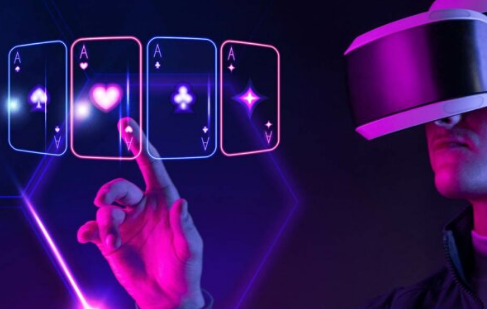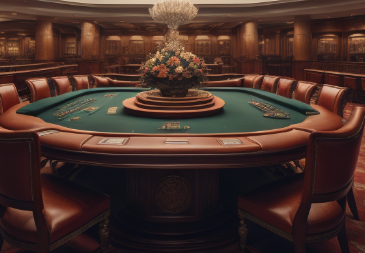

The online casino industry has undergone massive growth in recent years. As more players turn to internet gambling platforms for entertainment, casinos continue to push the boundaries of innovation to offer increasingly immersive experiences. The two technologies at the forefront are 3D graphics and virtual reality (VR).
Advanced 3D graphics utilized in online slots and table games have enhanced visual fidelity immensely over the past decade. Detailed environments with smooth animations are now the norm across reputable real-money casinos. However, VR takes immersion to the next level by replicating sensory depth similar to physical venues.
| TOP ONLINE CASINOS | |||||
| RANKING | CASINO | BONUS | BONUS | PLAY NOW | RATING |
1 | Exclusive Bonus Up to NZD$1000 + 100 Bonus Spins for $5! | $1000 |  |
||
2 | 4x deposit bonuses up to NZD$ 1,600 + 80 Bonus Spins for $1! | $1600 |  |
||
3 | $1000 |  |
|||
4 | $1200 |  |
|||
5 | $1500 |  |
|||
6 | Up to NZD $750 in Welcome Bonuses + 100 Free spins | $750 |  |
||
VR headsets and 3D stereoscopic displays allow a 360-degree view of meticulously modeled casino settings. Players feel transported as they interact with the environment. Augmented reality (AR) offers a blended approach by overlaying digital information onto real-world views. Think computer vision, which recognizes table game cards and projects next to real-time odds onto the live video feed within the player's eyewear.
These technologies aim to blur the lines between virtual gameplay and reality. So, what is the current landscape of 3D and VR adoption across internet casinos? And what does the future hold for further innovation to push new heights of realism for online gamblers?

While 3D graphics are now ubiquitous, virtual and augmented reality adoption in online casinos is still in its early stages. However, various pioneers have begun laying the infrastructure and offerings to accelerate growth.
For example, SlotsMillion became the first fully-fledged VR casino back in 2015. Players don VR headsets to be immersed as avatars in a virtual lobby and gaming floor, interacting with others in a shared simulated environment. The casino only features about three dozen Playtech and NetEnt VR games, but expansion is rapid as the hardware and software mature.
On the AR side, several startups now provide unique mobile apps to overlay odds or live projections onto physical table game setups. The computer vision capabilities transform gameplay into a hybrid digital arena. However, internet speeds still need to improve for mass consumer viability.
Industry projections estimate the current ~$400 million global VR gambling market to witness 800%+ growth by 2024. Several factors powering adoption ahead include:
As both software and hardware advance in capability while reducing costs, the stage is set for 3D and next-gen reality technologies to reshape internet casinos.
What exactly does the future look like for augmented and virtual reality casino games? How will these innovations transform player experiences?
VR can mimic the sights, sounds, and physical sensations of brick-and-mortar casino floors. Picture traversing a digital replica of the Las Vegas strip, entering hotels and lobbies modeled after their real-world counterparts. Players would observe Deal or No Deal games unfolding on hyperdetailed 4K screens. Roulette wheels spin with realistic physics, while slot reels have depth and shadows as on casino floors. The ultimate vision is for all sensory cues to mirror reality.
Haptic feedback via controllers, vests, or gloves could emulate the feeling of holding cards or chips. Special VR treadmills are already in development and allow walking through the virtual environment as console horsepower and display resolutions scale up, together with 5G cloud gaming, near-perfect simulations approach feasibility over the next decade.
While VR transforms users into a virtual environment, AR overlaps digital enhancements with real-world views. Next-gen augmented reality glasses can scan table game setups and project odds or strategy recommendations onto the video feed. We may one day see software recognizing poker tells via microexpressions and subtly hinting at the optimal plays.
AR also allows unique crossover experiences like starting slots within virtual lobbies before seamlessly transferring gameplay onto mobile screens when on the go. Geolocation data could render a worldview version of the game against physical surroundings!

While 3D and spatial computing innovations promise huge advancements for player experiences, they raise responsible gambling concerns around potentially increased addiction rates. By creating such immersive, lifelike simulations, more players could lose grasp of their surrounding realities and play irresponsibly for dangerously long periods.
Regulators continue working with research bodies to study the effects of persistent VR and form updated policy frameworks. However, casinos themselves must also mitigate risk factors in implementation. Some measures industry white papers propose include:
Visible reality anchors - Occasional transparency views of actual surroundings within the VR environment could ground users. Gentleness reminders help some players regulate sessions.
Visible responsible gaming messages – AR overlays showing elapsed playing duration and cash spent could encourage reflection and balanced habits.
Computer vision for behavioral analytics – AI tracking fatigue signs, emotional states, and gameplay variance could trigger risk alerts and intervention offers.
Seamless RG resources – Direct menu links to budget caps, loss limit tools, or helplines integrated natively within games keep resources conveniently accessible.
The technologies may be futuristic, but social responsibility principles remain unchanged. With proactive ethics codes and evidence-driven policies, the industry can responsibly fulfill the vast potential of 3D and XR advances.
Immersive digital realities mark a new frontier for internet casinos, but specific challenges remain for widespread adoption.
Further hardware improvements must address lingering issues like motion sickness in VR. Network infrastructure requires enhancement for highly responsive augmented streams. The games and mechanics need redevelopment for new dynamics that leverage spatial computing.
Policy debates around responsible gambling protections, age verification, and data privacy continue evolving on the regulatory side. The growth also hinges on establishing technical standards that allow interoperability across various devices and platforms.
Yet the momentum is undeniable. Giants like Microsoft, Google, Apple, and leading casinos all race to stake early claims in readiness for the paradigm shift. Capabilities achieve inflection points through the coalescence of maturing VR engines, 5G cloud access, AI integration, and more. The writing is clearly on the digital wall - highly immersive 3D, AR, and VR are set to penetrate online gambling significantly over the coming years.
Synthesizing all dynamics explored, 3D graphics and spatial computing will likely revolutionize internet casinos over the next decade. We anticipate more online providers to adopt VR platforms with photorealistic environments and expect AR integrations to transform portions of hybrid gameplay.
The ultimate destination is a unified ecosystem where players fluidly cross dimensions barriers between virtual and real. Your custom avatar could meet friends for poker in a virtual lounge facilitated by AI dealer overseers. The same software then projects odds onto your shades screen during live sports betting sessions at an actual stadium.
While expansive potential shines ahead, prudent policy and corporate diligence must also continue guiding the innovations to sustainable echelons. But the future undoubtedly looks captivating through those high-tech VR goggles!
VR headsets and 3D stereoscopic displays allow a 360-degree view of meticulously modeled casino settings. Players feel transported as they interact with the environment. Augmented reality (AR) offers a blended approach by overlaying digital information onto real-world views. Think computer vision, which recognizes table game cards and projects next to real-time odds onto the live video feed within the player's eyewear.
These technologies aim to blur the lines between virtual gameplay and reality. So, what is the current landscape of 3D and VR adoption across internet casinos? And what does the future hold for further innovation to push new heights of realism for online gamblers?
While 3D graphics are now ubiquitous, virtual and augmented reality adoption in online casinos is still in its early stages. However, various pioneers have begun laying the infrastructure and offerings to accelerate growth.
For example, SlotsMillion became the first fully-fledged VR casino back in 2015. Players don VR headsets to be immersed as avatars in a virtual lobby and gaming floor, interacting with others in a shared simulated environment. The casino only features about three dozen Playtech and NetEnt VR games, but expansion is rapid as the hardware and software mature.
On the AR side, several startups now provide unique mobile apps to overlay odds or live projections onto physical table game setups. The computer vision capabilities transform gameplay into a hybrid digital arena. However, internet speeds still need to improve for mass consumer viability.
Industry projections estimate the current ~$400 million global VR gambling market to witness 800%+ growth by 2024. Several factors powering adoption ahead include:
As both software and hardware advance in capability while reducing costs, the stage is set for 3D and next-gen reality technologies to reshape internet casinos.
What exactly does the future look like for augmented and virtual reality casino games? How will these innovations transform player experiences?
Complete Sensory Immersion
VR can mimic the sights, sounds, and physical sensations of brick-and-mortar casino floors. Picture traversing a digital replica of the Las Vegas strip, entering hotels and lobbies modeled after their real-world counterparts. Players would observe Deal or No Deal games unfolding on hyperdetailed 4K screens. Roulette wheels spin with realistic physics, while slot reels have depth and shadows as on casino floors. The ultimate vision is for all sensory cues to mirror reality.
Haptic feedback via controllers, vests, or gloves could emulate the feeling of holding cards or chips. Special VR treadmills are already in development and allow walking through the virtual environment as console horsepower and display resolutions scale up, together with 5G cloud gaming, near-perfect simulations approach feasibility over the next decade.
Crossing Dimensions with AR
While VR transforms users into a virtual environment, AR overlaps digital enhancements with real-world views. Next-gen augmented reality glasses can scan table game setups and project odds or strategy recommendations onto the video feed. We may one day see software recognizing poker tells via microexpressions and subtly hinting at the optimal plays.
AR also allows unique crossover experiences like starting slots within virtual lobbies before seamlessly transferring gameplay onto mobile screens when on the go. Geolocation data could render a worldview version of the game against physical surroundings!
While 3D and spatial computing innovations promise huge advancements for player experiences, they raise responsible gambling concerns around potentially increased addiction rates. By creating such immersive, lifelike simulations, more players could lose grasp of their surrounding realities and play irresponsibly for dangerously long periods.
Regulators continue working with research bodies to study the effects of persistent VR and form updated policy frameworks. However, casinos themselves must also mitigate risk factors in implementation. Some measures industry white papers propose include:
Visible reality anchors - Occasional transparency views of actual surroundings within the VR environment could ground users. Gentleness reminders help some players regulate sessions.
Visible responsible gaming messages – AR overlays showing elapsed playing duration and cash spent could encourage reflection and balanced habits.
Computer vision for behavioral analytics – AI tracking fatigue signs, emotional states, and gameplay variance could trigger risk alerts and intervention offers.
Seamless RG resources – Direct menu links to budget caps, loss limit tools, or helplines integrated natively within games keep resources conveniently accessible.
The technologies may be futuristic, but social responsibility principles remain unchanged. With proactive ethics codes and evidence-driven policies, the industry can responsibly fulfill the vast potential of 3D and XR advances.
Immersive digital realities mark a new frontier for internet casinos, but specific challenges remain for widespread adoption.
Further hardware improvements must address lingering issues like motion sickness in VR. Network infrastructure requires enhancement for highly responsive augmented streams. The games and mechanics need redevelopment for new dynamics that leverage spatial computing.
Policy debates around responsible gambling protections, age verification, and data privacy continue evolving on the regulatory side. The growth also hinges on establishing technical standards that allow interoperability across various devices and platforms.
Yet the momentum is undeniable. Giants like Microsoft, Google, Apple, and leading casinos all race to stake early claims in readiness for the paradigm shift. Capabilities achieve inflection points through the coalescence of maturing VR engines, 5G cloud access, AI integration, and more. The writing is clearly on the digital wall - highly immersive 3D, AR, and VR are set to penetrate online gambling significantly over the coming years.
Synthesizing all dynamics explored, 3D graphics and spatial computing will likely revolutionize internet casinos over the next decade. We anticipate more online providers to adopt VR platforms with photorealistic environments and expect AR integrations to transform portions of hybrid gameplay.
The ultimate destination is a unified ecosystem where players fluidly cross dimensions barriers between virtual and real. Your custom avatar could meet friends for poker in a virtual lounge facilitated by AI dealer overseers. The same software then projects odds onto your shades screen during live sports betting sessions at an actual stadium.
While expansive potential shines ahead, prudent policy and corporate diligence must also continue guiding the innovations to sustainable echelons. But the future undoubtedly looks captivating through those high-tech VR goggles!